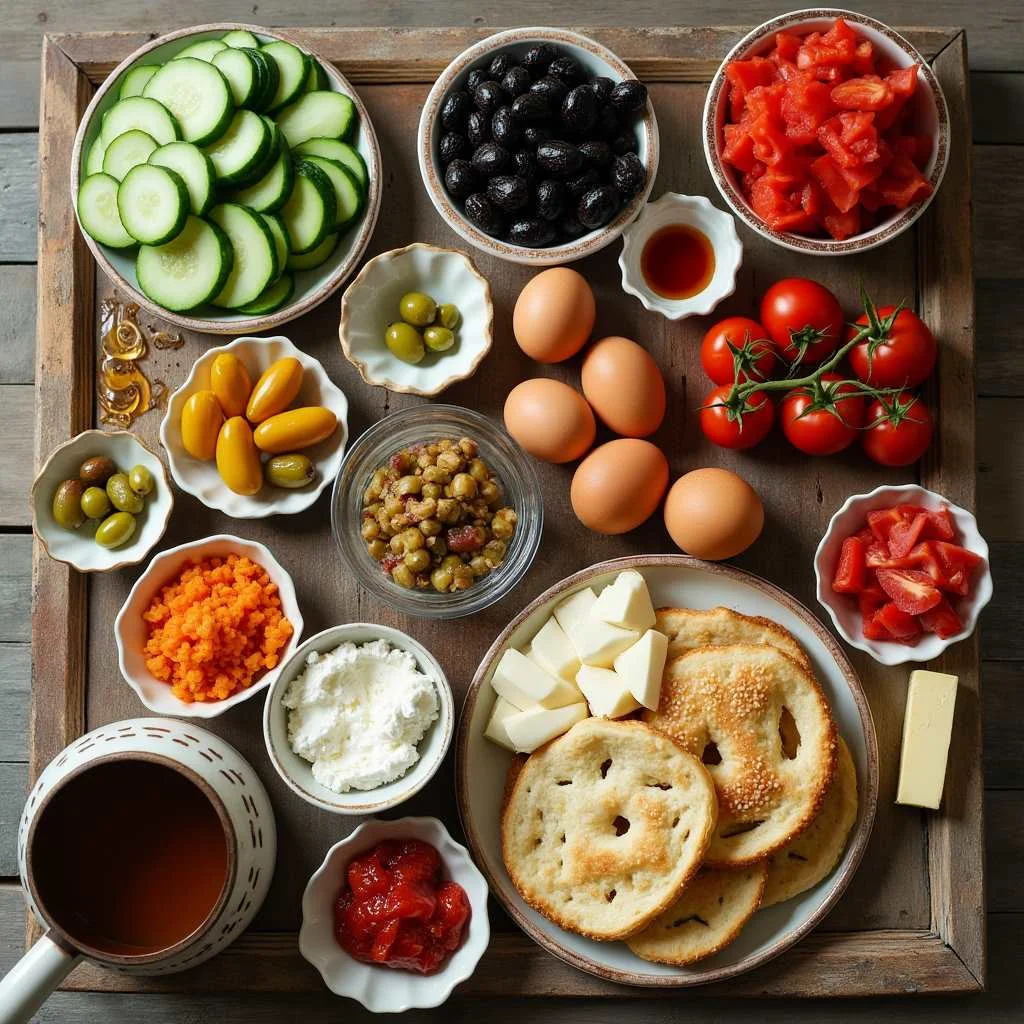Traditional Turkish Breakfast: Why It’s the Best Morning Meal
Tired of the same boring breakfast routine? Soggy cereal and rushed toast simply don’t provide the nourishment or satisfaction your body craves at the start of the day. A Traditional Turkish Breakfast offers a vibrant alternative that transforms your morning into a celebrated ritual rather than a forgettable pitstop.
This authentic Mediterranean spread combines sweet and savory elements in perfect harmony, creating a breakfast experience that energizes your body and delights your taste buds. As someone who lived in Istanbul for three years and studied under local chefs, I’ve perfected the art of creating this morning feast in both authentic and accessible ways.
In this comprehensive guide, you’ll discover everything from selecting the finest ingredients and proper presentation techniques to understanding the cultural significance that makes Traditional Turkish Breakfast so special. Whether you’re looking to impress weekend guests or elevate your daily routine, this breakfast tradition delivers on all fronts.
Table of Contents
Why This Breakfast Recipe Works
- Uses readily available ingredients that can be found in most supermarkets
- Components can be prepared ahead of time for quick assembly
- Provides balanced nutrition with protein, healthy fats, and complex carbohydrates
- Naturally accommodates various dietary needs (vegetarian, gluten-free options)
- Encourages mindful eating and social connection rather than rushed consumption
- Combines multiple flavors and textures for a satisfying sensory experience
Choosing the Right Ingredients
Essential Components of Traditional Turkish Breakfast
The beauty of Traditional Turkish Breakfast lies in its variety. While regional variations exist, a proper spread always includes:
- Fresh bread (simit or pide)
- Selection of cheeses (beyaz peynir or feta is mandatory)
- Olives (both black and green varieties)
- Fresh vegetables (tomatoes, cucumbers, peppers)
- Eggs (typically prepared as menemen or soft-boiled)
- Honey and preserves
- Turkish tea (served in small tulip-shaped glasses)
Buying Tips
Look for authentic Turkish or Mediterranean products at specialty markets for the most traditional flavors. Fresh ingredients are paramount—bright, firm vegetables and freshly baked bread make a significant difference in quality. When selecting olives, opt for brined varieties rather than canned for authentic taste and texture.
Substitutions
If you can’t find specific Turkish ingredients, here are smart substitutions:
- Use feta cheese in place of beyaz peynir
- Substitute bagels or crusty bread for simit
- Replace kaymak (clotted cream) with high-quality mascarpone mixed with a touch of honey
- Use orange blossom honey if you can’t find traditional Turkish honey
Ingredients & Prep


Breakfast Table Essentials
A Traditional Turkish Breakfast isn’t about a single dish but rather a collection of small plates that create a bountiful table. Prepare small bowls for:
- Sliced cucumber and tomato with a light drizzle of olive oil and sprinkle of sea salt
- Mixed olives with a touch of olive oil and dried oregano
- High-quality honey in a small dish with a serving spoon
- Fruit preserves (cherry, apricot, fig, or strawberry are traditional choices)
- Butter at room temperature for easy spreading
Protein Components
- Eggs: Prepare menemen (Turkish-style scrambled eggs with tomatoes and peppers) or soft-boiled eggs for protein
- Cheese Platter: Arrange 2-3 varieties including a white cheese (beyaz peynir or feta), a yellow cheese (kaşar or gouda), and if desired, a soft cheese like labne
- Optional Meat: Sucuk (spicy Turkish sausage) fried until crisp-edged, or thinly sliced pastırma (air-dried cured beef)
Bread Selection
Fresh bread is non-negotiable for an authentic experience. Consider:
- Simit (sesame-encrusted bread rings)
- Pide (Turkish flatbread)
- Açma (soft, buttery rolls)
- Börek (filled pastries with cheese or spinach)
Step-by-Step Preparation Instructions
Pre-Breakfast Prep
- Set the table with small plates, bowls, and serving utensils
- Prepare tea in a traditional two-tiered teapot (çaydanlık) or regular teapot
- Slice vegetables and arrange cheeses, removing them from refrigeration 30 minutes before serving
- Heat any bread products that taste better warm
Menemen (Turkish Scrambled Eggs) Preparation
- Sauté 1 diced onion and 1 diced green pepper in olive oil until softened
- Add 2 diced tomatoes, cook until they release their juices
- Season with salt, pepper, and a pinch of red pepper flakes
- Beat 4 eggs lightly, pour over the mixture
- Cook on low heat, stirring occasionally, until eggs are just set but still soft
Serving Method
- Present all items simultaneously on the table family-style
- Pour hot tea into small tulip-shaped glasses, serving with sugar cubes
- Encourage diners to create their own combinations of flavors
- Replenish tea throughout the meal as it serves as both beverage and digestif
Timing Guidance
- Total prep time: 30 minutes
- Best enjoyed: Leisurely over 1+ hours
- Ideal timing: Weekend mornings when time allows for unhurried enjoyment
Pro Tips for Perfect Turkish Breakfast
Creating Authentic Flavor
- Temperature Contrast: Serve hot tea alongside room-temperature foods for traditional experience
- Flavor Balancing: Always alternate between sweet (honey, jam) and savory (cheese, olives) components
- Bread Strategy: Save some bread for “swiping” plates clean at the end
- Tea Technique: Brew strong tea concentrated in the upper pot, dilute with hot water from the lower pot to preferred strength
Essential Tools
- Small serving bowls for individual components
- Turkish tea glasses and saucers if available (small glass mugs work as alternatives)
- Two-tiered teapot for authentic tea preparation
- Small spoons for jams and honey
Make-Ahead Options
- Prepare vegetable platters the night before, storing covered in the refrigerator
- Set the table before bed to streamline morning preparation
- Pre-slice cheeses and store between wax paper sheets
Flavor Variations
Regional Turkish Adaptations
- Black Sea Region: Add kuymak (cheese polenta) and cornbread
- Central Anatolia: Include higher percentage of pastries like börek
- Mediterranean: Incorporate more fresh herbs and olive varieties
- Eastern Turkey: Add stronger cheeses and herb mixtures like zahter
Health-Conscious Modifications
- Low-Carb Option: Emphasize eggs, cheese, vegetables and reduce bread portions
- Vegan Adaptation: Substitute tofu scramble for eggs, plant-based cheeses, and dairy-free spreads
- Reduced Sodium: Choose low-sodium olives and cheeses, emphasizing fresh components
International Fusion Ideas
- Mediterranean Twist: Add hummus and baba ganoush
- American Influence: Include avocado toast on Turkish bread
- European Touch: Incorporate high-quality charcuterie alongside traditional items
Serving Suggestions
Traditional Turkish Breakfast stands beautifully on its own, but you can enhance the experience with:
- Fresh-squeezed orange juice alongside Turkish tea
- Fresh fruit plate featuring seasonal offerings
- Turkish coffee to conclude the meal (never served during breakfast)
- Fresh mint or parsley sprigs as garnish for color and freshness
Traditionally, this breakfast is enjoyed at a leisurely pace, often stretching into the late morning hours. The meal becomes as much about conversation and connection as it is about the food itself.
FAQs
Can I prepare Turkish breakfast for weekday mornings? While the full spread is traditionally reserved for weekends, you can create a simplified version by choosing 3-4 key components (such as bread, cheese, and jam) for busier mornings.
How do I keep bread fresh for Turkish breakfast? Store bread in cloth bags at room temperature or freeze and toast just before serving. Avoid refrigeration as it dries bread out.
Is Turkish breakfast suitable for children? Absolutely! The variety of options allows children to explore new flavors while still finding familiar favorites. The honey and jam components are particularly appealing to younger palates.
What’s the difference between Turkish and Greek breakfast? While similarities exist, Turkish breakfast tends to offer greater variety and more small plates. Greek breakfast often features yogurt more prominently than Turkish breakfast.
Is it authentic to include hummus in Turkish breakfast? Hummus is not traditionally part of Turkish breakfast but rather belongs to Levantine cuisine. For authenticity, save hummus for other meals.
Looking for more turkish ideas, reach the following:
- What Makes Turkish Breakfast Food So Unique? Learn About Its Varieties
- Turkish Breakfast Dishes: How to Create the Perfect Morning Spread
Conclusion
Traditional Turkish Breakfast represents more than just a meal—it’s a celebration of morning, a tribute to fresh ingredients, and an invitation to slow down and savor life’s simple pleasures. Unlike rushing through breakfast or skipping it entirely, this ritual honors the importance of beginning your day with intention and nourishment.
The next time you want to elevate your morning experience or create a memorable gathering for loved ones, arrange your table with these Turkish delights. The combination of fresh vegetables, creamy cheeses, olives, honey, and warm bread creates a symphony of flavors that truly earns its reputation as the world’s best morning meal.
Join thousands of food enthusiasts who have discovered the joy of Traditional Turkish Breakfast and transformed their morning routine forever. Your taste buds—and your sense of wellbeing—will thank you.
How did you find our Post?
There are no reviews yet. Be the first one to write one.

